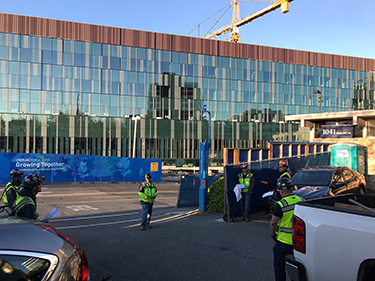|
Subscribe / Renew |
|
|
Contact Us |
|
| ► Subscribe to our Free Weekly Newsletter | |
| home | Welcome, sign in or click here to subscribe. | login |
Construction
| |
 |
January 21, 2021
Flexibility and collaboration: How teamwork paved the way for an innovative health care project
UMC

Eppler
|
Flexibility has been a key focus in facility design and construction thinking for many years. From planning spaces that are easily adaptable to changing technological and user needs, designing infrastructure that makes rapid changes possible, and inventing construction methods that support these needs both economically and time-wise, AEC firms have partnered to support a quickly changing world. Overlake Medical Center’s Project FutureCare was conceived with an astute vision focused on flexibility.
We often think of flexibility on a building project in terms of the design of the building. The planning and design lead the efforts for flexible spaces. However, once construction has commenced, a broader perspective toward flexibility comes into play — the ability to innovate, change or react as a team without impact to time, effort, cost or performance. During construction of Overlake’s new East Tower, the second phase of Project FutureCare, numerous opportunities to flex and bend as a team were vital to the success of the project. And when COVID-19 reared its head in the home stretch, a whole new dimension to flexibility came into play.
NEW IDEAS IN CONSTRUCTION
Early in the construction of the East Tower, UMC presented an idea to employ an innovative prefabricated riser shaft support frame for the shaft openings on each floor. The new tower has a basement mechanical plant and a rooftop equipment penthouse. Piping comes up from the lower levels of the building while large ducts come down from the roof.
In a multi-floor building, the challenge is bringing the services to the top while beginning construction at the bottom. Traditionally, installing the supplemental steel, pouring the floors with the correct openings, allowing for shaft framing and construction, and having the seismic and supports figured out from top to bottom by the first elevated deck pour is a challenge for on-site crews. Instituting the prefabricated shaft assembly reduced field installation time, eliminated supplementary steel framing, and provided a cleaner, safer floor opening.
The installation of services in the shaft, both for UMC and all other trades, was a more efficient and organized process for the whole team. This was the first project where UMC utilized its prefabricated riser shaft support frame with noticeably positive results.
TEAMING FOR TOP RESULTS
One of the more complex pre-COVID operations UMC was involved in was the shutdown/tie-in procedure for the hospital’s medical gas system. This complicated operation took months of planning between UMC and GLY; hospital representatives from all affected departments; insurance reps; many facilities and operational departments; Airgas, Medgas Services; and others.
Since it would shut down Overlake’s South Tower containing 24/7 operational spaces for a period of time, to ensure there was no interruption to the facility’s critical systems, the team isolated the entire South Tower, including the emergency room and surgery suites, to back feed it while tying its system to the new services.
After weeks of planning, teamwork and coordination, the long and complex shutdown was executed flawlessly with no interruption to ongoing operations.
MINIMIZING COVID DELAYS
When COVID-19 was emerging in March the Overlake team had to react quickly to produce plans for responsibly and safely continuing work on these essential projects, well ahead of the governor’s office issuing mandated guidelines for construction work. The team worked together to propose and approve unprecedented protocols. GLY closed the project for one week and then reopened the job smartly in phases with about 50 people at a time spread out through the 240,000-square-foot building.
The protocols controlled the flow of workers to avoid contact with others, implemented sanitation and cleaning practices, and applied contact tracing procedures — every person was known by name and where they were working so if a challenge arose, it could be easily pinpointed. This new way of working imposed significant impacts on productivity. Yet, the close coordination and flexibility of the team on-site helped to minimize delays to the extent possible, resulting in only a two-month delay in the project schedule.
PREFAB KEEPS JOB MOVING
At the beginning of the pandemic, there was uncertainty as to whether the project would come back full strength at all. UMC quickly pivoted its fabrication shop’s safety protocols in parallel with efforts on jobsite coronavirus safety plans to be able to continue off-site mechanical and plumbing assembly fabrication. Organizing assemblies on carts in the shop — a safe, controlled environment — they were ready to go when the project came back. After delivery to the site, workers simply pulled the nearly completed plumbing assemblies off the carts, put them in place in the ceilings or in the walls, and made the final connections.
CREATIVE CLEANLINESS
When the coronavirus hit, the Center for Disease Control recommended frequent hand washing as one of the most effective ways to protect yourself and others from contracting COVID-19. Knowing that construction sites are inherently dirty areas, UMC’s foremen on the Overlake project came up with the idea to attach utility sinks to a backer board, each separated by a plywood barrier, and connect them to the site’s plumbing system so wash stations would be available for workers. The plumbing system was far enough along that they could put wash stations on every floor for soap and water access. These not only helped keep this project moving forward with better sanitization but became the prototype for UMC’s portable wash stations.
DESIGN FLEXES TO NEW NORM
The flexibility designed into the new tower allowed for important alterations to the building in response to the COVID-19 pandemic. One of those is the implementation and additional sequence of operations (mode) that allows several groups of rooms on most floors to become cohorts, grouped isolation rooms. The mode in these rooms uses 100% outside air and causes the patient rooms to attain negative air flow. These cohorts will provide needed space for the current pandemic and more flexibility in the event of a future pandemic.
CHANGING EASTSIDE HEALTH CARE
The Puget Sound region is witnessing what is being dubbed by some as the “Eastside Migration.” Approximately 2.5 million square feet of high-tech office space is expected to be completed by the end of 2021, bringing an influx of workers and residents to the area and a rising demand for modern, high-quality health care options in what had been an underserved area. Through flexibility and teamwork, the new East Tower’s designers and builders have overcome unforeseen circumstances and will help transform health care opportunities for the growing Eastside.
Bryan Eppler is director of strategic development at UMC and project manager on the Overlake new East Tower project.
Other Stories:
- New tower makes campus more inviting, improves patient experience, saves energy
- 6 guiding questions help deliver world-class health care center



